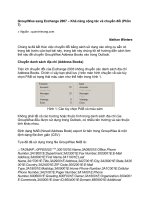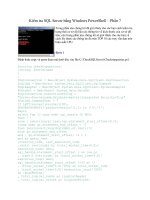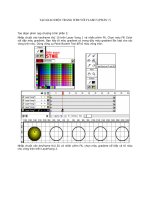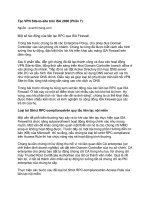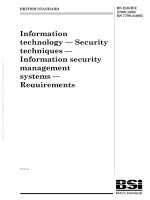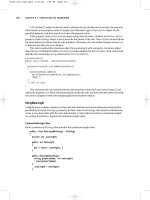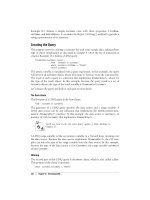Information Security FUNDAMENTALS phần 7 docx
Bạn đang xem bản rút gọn của tài liệu. Xem và tải ngay bản đầy đủ của tài liệu tại đây (2.02 MB, 26 trang )
procedure in place when an employee is terminated so that the access is
revoked quickly.
6.2.3 Account Authentication Management
In addition to managing the ongoing user permissions and revoking no
longer needed accounts, the information security manager should also
have a password management scheme in place. Passwords should be
changed on a regular basis; the current industry standard is around
30 days. However, the time to change passwords should reflect the security
necessary to protect the information on the system. It is not uncommon
for an organization to change passwords every 90 days, or longer. In
addition to having users change their passwords regularly, passwords
should be well selected. A well-selected password will be at least eight
characters in length, not based on a dictionary word, and contain at least
one unique character. The reason for these criteria is to make it more
difficult for an attacker to use a password cracking utility quickly. There
are two primary types of password cracking utilities: dictionary and brute
force. A dictionary password cracking utility is freely available on the
Internet and will a have word list of around 60,000 common words. An
attacker will typically begin a password attack using the dictionary cracking
tool. This tool, while not guaranteed to succeed in the attack, is much
faster than the brute-force password cracking tool. A brute-force password
cracking tool, also freely available from the Internet, will try every possible
combination of characters until it is successful. In recent tests, we have
seen that cracking an 11-character password with a brute-force password
cracking tool over a wide area network can take in excess of a month.
This means that if you have a good password change policy, you will
change the password before the brute-force password cracking utility has
adequate time to break the password.
With the common end user having, on average, an eight-character
password to remember for information technology resources, it can be
difficult for him or her to remember all of the passwords that are suffi-
ciently long and unique while also having the passwords change every
30 days. There is a technology available to help the information security
manager and the end user with password management. This technology
is single sign-on. The advantage to single sign-on is that each user has
only one password to remember for access to all network resources. This
allows the administrator to make the password both more complex and
changed more frequently without a large increase in the number of calls
to the help desk from those who have forgotten to reset their passwords.
Single sign-on technology has been beaten about the past few years, and
AU1957_C006.fm Page 143 Monday, September 20, 2004 3:23 PM
Copyright 2005 by CRC Press, LLC. All Rights Reserved.
is often still thought of as a mythical technology. In actuality, single sign-
on may not be possible but reduced sign-on is a very real possibility.
There are two primary approaches to single sign-on: script-based single
sign-on and host-based single sign-on. With script-based single sign-on, the
user logs in to the primary network operating system and when this
happens, the operating system runs a log-in program, often called a log-
in script, that will authenticate the user to other systems on the network.
The disadvantage to using this type of single sign-on is that the password
stored in the log-in script is often stored in plaintext, which means that no
encryption is used to protect the password in the file. Any entity that reads
this file will be able to recover the username and password for that user.
Also, these username and password combinations are often transmitted on
the network in plaintext. This allows any malicious user with a network
sniffer to capture the username and password. A network sniffer (see Figure
6.1) is a utility available for free on the Internet that is used to read all the
network packets on a network segment. This utility can be used for
troubleshooting, but can also be used maliciously to record log-in attempts.
The second type of single sign-on implementation is much more
commonly used than the script-based method mentioned previously. This
second type is known as host-based single sign-on because it uses a
FIGURE 6.1
Network Sniffer
AU1957_C006.fm Page 144 Monday, September 20, 2004 3:23 PM
Copyright 2005 by CRC Press, LLC. All Rights Reserved.
centralized authentication server or host. This implementation requires the
user to log into the authentication server and, when the user tries to
access other network resources, those applications contact the authenti-
cation server to verify the user’s access. There are a large number of
protocols that can be used for this type of single sign-on. Some of the
more common include Kerberos and RADIUS. There are a large number
of secondary authentication protocols that are not used as often; these
include protocols such as SESAME and RADIUS’ successor, DIAMETER.
Many of these authentication protocols can be configured to send the
username and password encrypted, and this can stop malicious users from
intercepting the username and password with a network sniffer.
6.3 System and Network Access Control
6.3.1 Network Access and Security Components
Protecting networking resources is one of the areas of information security
that currently receives the most focus. When thinking of security, senior
management often envisions firewalls, intrusion detection systems, and
other technological solutions, but often overlooks the importance of
integrating these with the existing user community. In this section we
focus on the technical components of network security and how the
technologies can be utilized to improve network security.
Many network devices are left in default or very similar to default
configurations. While leaving these devices in this state is often easier, it
can be a severe detriment to security. Most devices in this configuration
are running many unnecessary services; and while the user community
does not use these services, malicious users on the network can exploit
the vulnerabilities in these services. To minimize the amount of security
holes in the network, the information security manager must disable or
remove all the unnecessary services on the devices. This can quickly
become a double-edged sword because determining which services are
unnecessary can disable functionality of the system. If you ever have a
few spare minutes, look in the control panel on your Microsoft Windows
system and see how many services are running on that system, but do
not disable any service unless you know what the service does. It is very
easy to make a nonfunctional system this way.
Normally, a user with the appropriate access control is able to use any
PC or workstation on the local area network to run an application or
access certain data. However, where such data or system is classified as
sensitive or requires restricted physical access, an enforced path may be
applied. This is a straightforward configuration setting, performed by the
information security manager, whereby access is restricted to a specific
AU1957_C006.fm Page 145 Monday, September 20, 2004 3:23 PM
Copyright 2005 by CRC Press, LLC. All Rights Reserved.
workstation or range of workstations. Enforcing the path will provide
added security because it reduces the risk of unauthorized access, espe-
cially where such a workstation is itself within a secure zone, requiring
physical access codes or other physical security mechanisms.
The typical network uses user authentication, wherein a user provides
a username for identification and a password for authentication. In some
networks the authentication requires not just user authentication but node
authentication as well. There are many different ways to get node authen-
tication; it can be from a digital certificate issued to the machine, based
on the system’s IP address, or from the systems hardware address itself.
Using any of these authentication components with the user authentication
component is not a good idea. With the exception of the digital certificate,
it is very easy to change an IP address or hardware address to “spoof”
an address of an authorized machine (see Figure 6.2). Spoofing the user
on the rogue machine changes the system or IP address of the system to
be that of another system that is trusted or permitted on network. The
task of using hardware address node authentication was offered as a
security solution to the problems with wireless networks. This authenti-
cation was easily bypassed with spoofing, leading to the same security
problems that existed previously.
Another key component of network security is to have network mon-
itoring in place. One of the easiest ways to have the security of monitoring
the network is to implement remote port protection. This would allow an
information security manager to see if a new port becomes active on a
switch or hub. “Port” is the term for one of the hardware interfaces on a
hub or switch. Most hubs or switches are classified by the number of
ports on them. You will often hear of 24 port switches, which means that
there are 24 slots for network cables to be connected to the switch. In
most environments, there are ports that are not used and left open. If an
attacker is able to get physical access to the switch, he can plug a new
network device into the open port in the switch. Because this might lead
to a security breach, the information security manager should be notified
if one of these switch ports that is left open suddenly becomes active.
This is where having remote port detection can provide security.
Yet another way to keep your network secure is to minimize the
number of devices on a network that interact. To do this, the information
security manager may choose to have network segregation. There are
many mechanisms for getting segregation in the network. These include
using physical distance, virtual local area networks, network address
translation, and routing. To use physical distance, the information security
manager does not allow the groups of network devices to be connected
to the same hubs or switches as the other networks. This seems rather
crude, but it can be quite effective. Imagine that, on a multi-floor building,
AU1957_C006.fm Page 146 Monday, September 20, 2004 3:23 PM
Copyright 2005 by CRC Press, LLC. All Rights Reserved.
FIGURE 6.2
Spoofing Hardware
AU1957_C006.fm Page 147 Monday, September 20, 2004 3:23 PM
Copyright 2005 by CRC Press, LLC. All Rights Reserved.
the Research & Development department occupies the fourth floor and
no other user community needs to access this department. To stop other
users from accessing this department, the information security manager
can simply choose to not have the Research & Development department
share the hub or switch with the other networks. While this method
requires additional hardware, it is the easiest to manage. If additional
hardware is not available, the information security manager may choose
to do the same segregation logically. To do this, the information security
manager would use virtual local area networks. This allows one physical
switch to be split into multiple logical switches. While the security using
the virtual local area networks is not as good as the actual physical
network, it can be quite good. The information security manager may
choose to segregate the networks using address translation and routing.
In both of these examples, the information security manager will use the
different IP address ranges that have been administratively assigned to
block communication between networks. The only real drawback to using
this type of method for network segregation is if your organization is
using Dynamic Host Configuration Protocol (DHCP). If your network uses
DHCP, a server will automatically assign an IP address for all devices
plugged into that network segment. A user can bypass the security of
network address translation and routing by plugging the device into a
new location and receiving a new IP address.
Of course, one of the most often thought of mechanisms for getting
network segregation is to use a firewall. Firewalls were originally an iron
wall that protected train passengers from engine fires. These walls did
not protect the engineer. This might be a lesson for information security
managers. In early networks, a firewall was a device that protected one
segment of a network from failures in other segments. However, the more
modern firewall is a device that protects an internal network from mali-
cious intruders on the outside. All firewalls use the concept of screening,
which means the firewall receives all the network traffic for a given
network, and it inspects the traffic and either allows or denies the traffic
based on the configuration rules on the firewall device itself. Many early
firewalls would have a set of rules that would deny traffic that was not
necessary for the business to function. Eventually, this migrated from a
list of traffic to deny and accepting all other types of traffic, to a list of
traffic to accept and denying all other types of traffic. This is often said
to be a “deny all” firewall unless it is an expressly permitted type of
firewall. These types of firewalls are currently the most common. There
are three primary types of technology currently in use: the packet filter,
the stateful inspection, and the proxy-based firewalls.
The packet filter firewall was the first firewall released and is often
considered the simplest firewall. It works off a list of static rules and
AU1957_C006.fm Page 148 Monday, September 20, 2004 3:23 PM
Copyright 2005 by CRC Press, LLC. All Rights Reserved.
makes the determination based on the source IP address, destination IP
address, source port, and destination port. With a packet filter firewall,
one of the common rules necessary to permit the network to have Web-
based Internet access is a rule that allows all high ports (those above
1024) from all Internet sources into the organization. This allows any hosts
on the Internet to send packets into the network over a high port and
the firewall will permit it. This creates a rather large security hole in the
organization.
The two second-generation firewalls — the stateful inspection and
proxy — do not have this security hole. The stateful inspection firewall
functions similar to the packet filter firewall but has a small database that
allows for the dynamic creation of rules that allow for response traffic to
enter back into the firewall. This provides end users with the ability to visit
Web pages without creating the rule necessary for the response traffic to
be allowed in. The stateful inspection firewall will dynamically allow the
response traffic in if the traffic was permitted outbound.
The proxy-based firewall has nothing in common with the packet filter
firewall. The proxy-based firewall actually functions by maintaining two
separate conversations. One conversation occurs between the client and
the proxy firewall, and the other conversation occurs between the desti-
nation server and the proxy firewall. The proxy firewall uses more of the
IP packet to make the determination of whether or not to permit the traffic.
This often causes some performance degradation, but can give increased
security.
The information security manager often has to decide between easier
administration and increased security. This is the case when it comes to
control of the network routing. There are a number of routing protocols
(such as RIP, OSPF, and BGP) that can be used. Anytime one of these
routing protocols is used, it can make administration easier, but there is
the security risk of having an intruder send false information over the
router update protocol and corrupting the router’s information table.
6.3.2 System Standards
There is difficulty in supporting multiple systems for the information
security manager and the support staff. To minimize the differences
between systems, it might be in the best interests of your organization to
create a standard. This standard would then be a recommended guideline
for how the systems should be configured and what software packages
should be installed on the systems. This will also help minimize the
amount of non-standard applications that will be installed but can have
a dangerous security impact on the network.
AU1957_C006.fm Page 149 Monday, September 20, 2004 3:23 PM
Copyright 2005 by CRC Press, LLC. All Rights Reserved.
6.3.3 Remote Access
Remote access is a favorite target of hackers because they are trying to
gain remote access to your organization’s network. As such, additional
security controls must be deployed to protect remote access and remote
access services. Some of the more commonly deployed technologies
include virtual private networking (VPN) and two-factor authentication.
Virtual private networking takes advantage of encryption technologies to
help minimize the exposure of allowing outside users to have access to
the network.
Two-factor authentication is another technology that can help protect
remote access. It uses multiple types of authentication technologies to
provide for stronger authentication. Authentication can often be broken
down into three categories: something the user has, something the user
knows, and something the user is. The most commonly used authentication
comes from the “something the user knows” category. This would include
things such as:
Ⅲ
Passwords
Ⅲ
PINs
Ⅲ
Passphrases
From the “something the user has” category, we would be looking at
authentication components such as:
Ⅲ
Smart cards
Ⅲ
Magnetic cards
Ⅲ
Hardware tokens
Ⅲ
Software tokens
And from the “something the user is” category, we would be looking at
biometrics and other behavior-based authentication systems. Biometric
devices use unique characteristics of each person, including:
Ⅲ
Fingerprints
Ⅲ
Retina patterns
Ⅲ
Hand geometry
Ⅲ
Palm prints
Two-factor authentication takes an authentication component from two
of the groups mentioned above. This requires more than just a username
and password to get access. Because remote access connections to the
network originate from outside the network, it is a prime location for
stronger authentication controls.
AU1957_C006.fm Page 150 Monday, September 20, 2004 3:23 PM
Copyright 2005 by CRC Press, LLC. All Rights Reserved.
6.4 Operating System Access Controls
6.4.1 Operating Systems Standards
As discussed previously, standards can minimize the amount of customi-
zation of employee workstations and this can minimize the difficulty in
performing system and network maintenance. This can be extended further
through the use of operating system standards. These standards are
provided by a number of sources, including the manufacturer, third-party
security organizations, and the government. One of the most common
sources of operating system standards is the National Institute of Standards
and Technology (NIST). NIST provides standard profiles for varying levels
of system security configurations for most common operating systems. In
some cases, there are utilities to audit the system against the standard
configuration and point out where the system configuration is lacking in
meeting the required security profile. These standards cover the complete
range of operating system security, from the typical workstation to the
highly secure server. These standards allow the information security man-
ager to have a more detailed account of the modifications necessary to
appropriately configure system security. The NIST standards are available
from .
6.4.2 Change Control Management
One of the most unglamorous areas of information security is the change
control process. In many small organizations, change control is omitted
altogether and administration changes are made through an ad hoc pro-
cess. While not having a change control process reduces administrative
overhead, the resulting drawbacks are pretty severe. I know that there
were a number of organizations where I was the primary security admin-
istrator and spent the first few weeks of the job just running through the
existing configurations trying to figure out what the previous administrator
had done. This process can be as simple or as complex as your organi-
zation requires. In one organization, we implemented a simple change
control process wherein a simple paper form was filled out, the changed
was discussed at the next staff meeting, and the form was then stored in
a folder next to the server on which the change was made. With a small
number of servers and a tiny support staff, this process was adequate.
With very large companies where the number of information technology
support personnel can number in the hundreds or thousands, a process
needs to be much more scalable and detailed. A more advanced change
control process follows.
AU1957_C006.fm Page 151 Monday, September 20, 2004 3:23 PM
Copyright 2005 by CRC Press, LLC. All Rights Reserved.
Ⅲ
Step 1: Request of change is formally made.
This requires that the
proposed change is documented in written form.
Ⅲ
Step 2: Analyze request.
After the written request is made, a formal
risk assessment may be necessary to determine if the change will
have a severe impact on network security.
Ⅲ
Step 3: Develop the implementation strategy.
During this step, the
actual way the change will be made is discussed, responsibilities
are defined, and the implementation schedule is devised.
Ⅲ
Step 4: Calculate the costs of this implementation.
This step will
allow for the appropriate budget to be put together to implement
the change. A cost analysis may be done to see if the change
makes fiscal sense for the organization.
Ⅲ
Step 5: Review any security implications.
This step determines how
the level of risk for the organization will change once the change
is made. Often, the change will be made in a development (non-
production) environment before the actual change is made to
production systems. Having the change made in the development
network allows for security testing to be done prior to any changes
that would affect the production network.
Ⅲ
Step 6: Record change request.
In this step, all of the documentation
from the previous step is compiled.
Ⅲ
Step 7: Submit change request for approval.
At this point, all of the
documentation is put together and submitted to the information
security steering committee for approval.
Ⅲ
Step 8: Develop change.
If the change requires that code be written
or new software be acquired, the basis for the plan is done here.
Ⅲ
Step 9: Recode segments of the system.
In this step, if the change
requires that software be written, then the software is written. This
would also be where a new system is developed in the develop-
ment network and tested.
Ⅲ
Step 10:
Link these changes to the formal change control request.
Ⅲ
Step 11:
Submit software for testing and quality approval. Here,
the quality control or quality assurance group would review the
change for adequacy.
Ⅲ
Step 12:
Repeat until quality is adequate.
Ⅲ
Step 13: Implementation.
The code, system, or configuration change
is move into production at this point. If your organization has a
formal promotion to production sequence, it should be followed.
Ⅲ
Step 14: Update the version information.
At this point, all the
changes have been implemented, so the next phase is to update
the documentation and the user training materials, and to inform
the user community of the change.
Ⅲ
Step 15: Report changes to management.
In this step, tell manage-
ment that the change has been made and is working properly.
AU1957_C006.fm Page 152 Monday, September 20, 2004 3:23 PM
Copyright 2005 by CRC Press, LLC. All Rights Reserved.
The process listed above includes many steps that are not needed for
all organizations. Each organization is unique and the change control
process should be modified to fit the organization. The most important
steps are there to ensure that all changes are submitted, approved, tested,
and recorded. This ensures that no changes are made without the change
control process.
6.5 Monitoring System Access
6.5.1 Event Logging
Most current systems allow for enabling audit logs, and more and more
systems are enabling logging by default. As an information security man-
ager, you need to verify that event logging is enabled and is adequate
for the relative security level of the system. In addition to enabling the
logging, the log files must be reviewed regularly to detect possible security
breaches. With all of the logs coming from all of the different sources,
log correlation has become a hot issue during the past few years. If your
organization has numerous intrusion detection systems, firewalls, and
critical servers, it might be more useful to move to a central log recording
system. These systems can also manage one of the more difficult compo-
nents of log analysis: time synchronization. Many system clocks lose or
gain time as the system stays in an operating production environment. A
central log reporting system can also function as a network time server
to help all system clocks stay synchronized.
6.5.2 Monitoring Standards
In organizations that wish to use information security monitoring, it is a
good practice to include a warning banner on the systems before a user
is authenticated. These warning banners should have three components:
1. This system is for authorized users only.
2. All activities on this system are monitored
3. By completing the log-on process, you are agreeing to the monitoring.
The warning banner should not include the name of the organization
to which the system belongs; that information would be useful for social
engineering and other attacks. Also, the warning banner should never
include the “welcome” greeting. The best way to avoid legal issues with
warning banners is to keep them simple; include only what needs to be
included and nothing else.
AU1957_C006.fm Page 153 Monday, September 20, 2004 3:23 PM
Copyright 2005 by CRC Press, LLC. All Rights Reserved.
6.5.3 Intrusion Detection Systems
As previously discussed with single sign-on implementations, some tech-
nology has been the target of a bit of bad publicity lately. Intrusion
detection systems also fall into this category. Intrusion detection systems
(IDS) are designed to function like a burglar alarm on your house — from
a technical standpoint, of course. These systems should record suspicious
activity against the target system or network, and should alert the infor-
mation security manager or support staff when an electronic break-in is
underway. The biggest downfall with IDS products is the necessary level
of customization “of the box.” Without significant amounts of customiza-
tion, the IDS will produce a large number of false-positive alerts. A false
positive is created when the IDS alerts the support staff to an event that
will not have an impact on the target system. For example, a Code Red
attack against and Apache
Web server will not work, but the IDS may
still sound the alarm.
Underneath the hood, IDS products function either as a host-based
intrusion detection system (HIDS) or a network-based intrusion detection
system (NIDS). There are positives and negatives with each type. With
an HIDS product, the product protects the system by monitoring a single
system. There are a number of different ways that an HIDS can monitor
the system. One of the more common ways is for the HIDS product to
monitor all network traffic entering or leaving the host. The HIDS product
can also function by monitoring the log files on the system itself. The
disadvantage of using an HIDS product is that the product, by its very nature,
cannot detect common network preamble attacks such as a ping sweep.
A network-based intrusion detection system (NIDS) works by moni-
toring a network segment to determine if the network traffic matches the
pattern of a well-known network attack. This type of system can detect
preamble attacks such as a ping sweep, but can be fooled by high network
congestion and encryption. Also, the NIDS can have a lag time for new
network attacks being written to the intrusion detection system profile. A
new network attack may bypass the NIDS device until the attack pattern
can be written and the NIDS updated.
In recent years, the IDS have been moving toward a next generation
of security technology known as the intrusion prevention system (IPS)
(see Figure 6.3). The IPS functions as a traditional IDS system with
increased functionality. The IPS also takes on the functionality of a firewall,
an antivirus system, and a vulnerability scanner. These components help
reduce the number of false positives with the vulnerability scanner func-
tionality. The package can test for the vulnerability before sounding the
alarm. In addition to minimizing the number of false positives, the func-
tionality of the other components allows for increased protection.
AU1957_C006.fm Page 154 Monday, September 20, 2004 3:23 PM
Copyright 2005 by CRC Press, LLC. All Rights Reserved.
6.6 Cryptography
6.6.1 Definitions
The final powerful weapon we look at in this chapter to assist the
information security manager is cryptography. Cryptography is a branch
of mathematics that transforms data to keep messages secret. The secrecy
in cryptography has its basis in military operations. Cryptography was
used to send messages from the central command to the troops on the
battlefield without the enemy being able to understand a message if they
intercepted it. In the information security battle space of which we are a
part, cryptography for us is the denial of access to our messages of
unauthorized viewers. In addition to keeping our messages secret, we
also want to verify that our messages are coming from our central
command. To do this, we use the concept of authenticity. In most
information security environments, we can use a username and password
combination to verify the authenticity of the sender. However, in sending
a message between parties, it can be rather difficult to effectively use the
FIGURE 6.3 IDS to IPS Migration
AU1957_C006.fm Page 155 Monday, September 20, 2004 3:23 PM
Copyright 2005 by CRC Press, LLC. All Rights Reserved.
username and password combination to authenticate the message. In
addition to verifying that a message actually came from the appropriate
person and that only the intended recipient viewed the message, we also
want to ensure that the message was not modified along the way. To do
this, we use yet another component of cryptography— that of integrity.
When we put all these components together, we get
nonrepudiation
. The
message will be guaranteed to have come from the sender, gone only to
the recipient, and was not modified along the way.
What is cryptography to the information security manager? Cryptogra-
phy is the implementation of the science of secret writing. This is often
called “applied cryptography” by academic sorts. In information security,
the cryptosystem is what provides the secrecy of the message. The secrecy
our cryptosystem gives us is not absolute secrecy; it does not keep a
message secret forever. Rather, the cryptosystem’s goal is to keep the
message secret for such a period of time that if the cryptosystem were
defeated it would take longer than the time the message must be kept
secret. The goal of the cryptosystem is twofold: first is the time component
just discussed and the second is the cost to defeat the cryptosystem. If it
costs our competitor more money to defeat our cryptosystem than the
costs of the message if it is read by our competitor, then the cryptosystem
has accomplished its goal. The amount of time, effort, and resources
required to defeat the cryptosystem is known as the
work factor
. Work
factor does not just refer to the amount of CPU time necessary to defeat
the cryptosystem, but also the time necessary to develop the system that
will go about defeating the cryptosystem.
If a competitor is trying to break into our encrypted message by
defeating our cryptosystem, then our competitor is using cryptanalysis.
“Cryptanalysis” is the term for trying to defeat the cryptosystem without
the appropriate key. What we would be doing with the cryptosystem if
we tested our cryptosystem for relative strength is called cryptology.
Our cryptosystem transforms data from one form to another. The form
that is able to be read by anyone is called plaintext or cleartext. Once
the data has been processed through the cryptosystem, it becomes read-
able by only the intended recipient. This type of scrambled data is called
ciphertext. As we discuss later, there are two primary mechanisms by
which the data can be transformed. If it is transformed one character at
a time, it is called a stream cipher. If several characters from our message
are processed by the cryptosystem at once, the cryptosystem is called a
block cipher. We further discuss stream and block ciphers in the following
sections. As the cryptosystem transforms our plaintext into ciphertext, it
is called enciphering. The reverse process of transforming ciphertext into
plaintext is called deciphering. If you have ever tried to read a phone
AU1957_C006.fm Page 156 Monday, September 20, 2004 3:23 PM
Copyright 2005 by CRC Press, LLC. All Rights Reserved.
message written by someone with messy handwriting, you have tried to
decipher a message.
In 1883, a mathematician named Auguste Kerckhoff published a paper
in which he stated that the only secret component of a cryptosystem
should be the key. The component of the cryptosystem that actually
transforms the data is the algorithm. The algorithm is pretty easy to
distinguish from the rest of the cryptosystem; it is the part with all the
math involved. Kerckhoff stated that all encryption algorithms should be
publicly known because this is the only way that an algorithm can be
reviewed for security holes. He also stated that any algorithm that was
not publicly known would have more security holes than a publicly known
algorithm. This axiom is still true today, most cryptosystems use algorithms
that are publicly known. As previously discussed, Kerckhoff stated that
the only secret component should be the key. A key is the secret sequence
that governs the encipherment and decipherment of the message. It is
easiest to think of the key as the password to your cryptosystem. If you
do not know the password or key, you cannot read the secret message.
Due to the fact that the encryption key should always be kept secret,
it can present a problem distributing keys to a user community. Many
users lose their encryption keys, and the data often must still be recovered.
One of the many components that allows for this data to be recovered
is key clustering. With key clustering, another key can be used to encrypt
and decrypt the data. Another term that works along with key clustering
is “key escrow.” Key escrow occurs when a key, often used in emergency
purposes, is distributed to different individuals. This allows for the recovery
of data only when two people are working together. This stops an
administrator from using his key for malicious purposes.
The cryptosystem that you use to protect confidential messages in your
organization can use many different types of encryption systems. Encryp-
tion systems are how the cryptosystem and its algorithm can go about
transforming the data. There are many different types of encryption
systems and most algorithms can combine multiple types.
The first type of encryption system that we will look at is the classical
substitution cipher. If you have ever pulled a secret decoder ring out of
a cereal box, then you have possessed a classical substitution cipher. A
classical substitution cipher will replace one letter from the plaintext
message with another character to make the message encrypted. One of
the first cryptosystems used an algorithm known as the Caesar cipher.
The Caesar cipher substituted characters by shifting the alphabet three
spaces off a certain letter. For example, if we pick the letter “A,” the
cipher would move it forward three characters to the letter “D.” We could
then substitute all the letters “A” in our original message with the letter “D.”
AU1957_C006.fm Page 157 Monday, September 20, 2004 3:23 PM
Copyright 2005 by CRC Press, LLC. All Rights Reserved.
Here is an example our original message:
This is a plaintext message
Once we have processed the messages through the Caesar cipher using
“C” as our key, the encrypted message becomes:
Wklv lv d sodlqwhaw phvvdjh
As opposed to classical substitution ciphers, an algorithm could use a
transposition or permutation cipher. This cipher does not change one
letter for another; rather, it changes the sequence of the letters in the
message. A simple way to perform this operation is to write all the letters
of a word in reverse order.
Here is an example of the original message:
This is a plaintext message
Once we have processed the message through our transposition cipher,
we would end up with a message like this:
sihT si a txetnialp egassem
There are many other encryption systems available. Another type of
cipher is the poly-alphabetic cipher. The Caesar cipher that previously
discussed is also an example of a poly-alphabetic cipher in that the
message was switched from one alphabet (the one starting with the letter
“A”) to a new alphabet (the one starting with the letter “D”). Another
cipher is the running key cipher. With a running key cipher, all commu-
nications come from a preagreed-upon set of characters. For example, I
give you the encrypted message 1234. It probably would not seem like
a very well-encrypted message. But what if we had previously agreed
that “1” would mean “building one,” “2” would mean “floor two,” “3”
would mean “room three,” and “4” would mean “room four”? And on the
whiteboard of room four there was a message written; then we would
have a secret message. Concealment is another type of encryption system.
If you skip every third word in a message, there may be a secret message
hidden in it.
Steganography is not exactly a form of cryptography; it is actually
hiding in plain sight. The advantage of steganography is that no one can
tell that a secret message is being sent. With cryptography, anytime a
message is sent, someone could look at the message with a packet sniffer
and determine that the message was encrypted. With steganography, the
AU1957_C006.fm Page 158 Monday, September 20, 2004 3:23 PM
Copyright 2005 by CRC Press, LLC. All Rights Reserved.
same person with a packet sniffer would only see a photo or a music file
go by. Steganography hides hidden messages in pictures or music files.
This technology is currently being used in more organizations, and the
fear is that terrorist organizations are using similar technology. There was
an Internet rumor spreading around rapidly in 2002 that terrorists were
posting hidden messages in steganographed picture files on Internet
auction sites. After some research, the rumor was found to be false.
Do you remember your days of using pig Latin to speak in messages
in front of your parents? Pig Latin was an example of a code. A code is
just a generic term for agreeing on a system to hide messages.
There are also encryption machines. A machine that was most popular
was called the enigma machine. It had numerous rotors and switches that
were attached to a typewriter keyboard. When the wheels and switches
were turned by the Nazis in World War II, the machine would change
the keys pressed on the typewriter keyboard into another character on
the paper.
6.6.2 Public Key and Private Key
The two primary types of algorithms are private key and public key
algorithms. Private key algorithms are easier to set up for a small number
of users. All of the secrecy from private key algorithms comes from keeping
the key secure. The key, if exposed, will allow any person who has the
key to decrypt the message. Private key cryptography is also known as
symmetric cryptography because whatever process is done to encrypt the
message, the reverse process is done to decrypt the message.
In public key cryptography, there are two keys that are related. The
two keys in public key cryptography are known as the private key and
the public key. These keys are related so that anything encrypted with
the public key can be decrypted with the private key, and anything
encrypted with the private key can be decrypted with the public key. The
security in public key cryptography is in keeping the private key secure.
The public key is called the public key because anyone can have access
to it. Public key cryptography is also known as asymmetric cryptography
because the process done to encrypt the message is not done in reverse
to decrypt the message. The private key in public key cryptography acts
as a trap door that decrypts a message encrypted with the public key.
There can be many components to implement public key cryptography.
The technical structures necessary to implement public key cryptography
are collectively known as public key infrastructure (PKI). With PKI, public
keys are published as certificates on a certificate authority. PKI may have
all of the following components:
AU1957_C006.fm Page 159 Monday, September 20, 2004 3:23 PM
Copyright 2005 by CRC Press, LLC. All Rights Reserved.
Ⅲ Certification Authority (CA)
Ⅲ Registration Authority (RA)
Ⅲ Certificate Repository
Ⅲ Certificate Revocation List
6.6.3 Block Mode, Cipher Block, and Stream Ciphers
As previously discussed, ciphers can either encrypt data a single character
at a time (stream ciphers) or a number of characters at a time (block
ciphers). Figure 6.4 illustrates a block cipher encrypting a block of text
at a time.
As opposed to a block cipher, a stream cipher encrypts the message
a bit of text at a time. This means that a stream cipher breaks a message
down into 1’s and 0’s before the message is encrypted. To encrypt the
stream of 1’s and 0’s from the message, the stream cipher uses a component
known as a key stream generator. The key is then input into the key
stream generator to generate a stream of random 1’s and 0’s. The original
message is then put through a mathematical process known as exclusive
ORing (X-OR) where the two bits are compared. If the bit from the original
message is a 1 and the bit from the key stream generator is a 1, then the
encrypted message would send out a 0 or the first bit. If the two bits are
the same, the X-OR process yields 0; if the two bits are different, the
process yields a 1.
FIGURE 6.4 Block Cipher
ï Block Ciphers
DB1 DB2 DB3 DB4
CT1 CT2 CT3 CT4
Data Block 1 Data Block 2 Data Block 3 Data Block 4
AU1957_C006.fm Page 160 Monday, September 20, 2004 3:23 PM
Copyright 2005 by CRC Press, LLC. All Rights Reserved.
Consider the following example:
Original message: 1 0 1010101
Key stream: 0 1 0110100
–––––––––
Encrypted Message: 1 1 1100001
Because a stream cipher is generally less complex in terms of lines of
code necessary to implement it, a stream cipher is often used in hardware
(see Figure 6.5). The encryption protocol Wired Equivalent Privacy (WEP),
which is used by wireless networks, uses a stream cipher called RC4.
Because the randomness of the 1’s and 0’s coming from the key stream
generator is critical to the security of a stream cipher, there are rules that
must apply to a key stream generator. A key stream generator must have
long periods where the key stream does not repeat. The key stream must
be functionally complex, which means that the key stream cannot be the
key and then the key in reverse and then the key. The key stream must be
statistically unpredictable, which means there are no patterns to the key
stream. The key stream must be unbiased, which means there are as many
1’s as 0’s. The key stream cannot be easily related to the key. All of these
rules increase the security and secrecy of a stream cipher.
6.6.4 Cryptanalysis
Bad guys do cryptanalysis. Well …, not just guys and not all of them are
bad; but cryptanalysis is the process of trying to defeat cryptography
FIGURE 6.5 Stream Cipher
Key
Keystream
Generator
Keystream
11010001
Plaintext
01001000
Ciphertext
10011001
AU1957_C006.fm Page 161 Monday, September 20, 2004 3:23 PM
Copyright 2005 by CRC Press, LLC. All Rights Reserved.
without the secret key. The most common type of cryptanalysis is the
ciphertext-only attack. This occurs when an attacker looks at the encrypted
messages with a utility such as a network sniffer and looks at the stream
of ciphertext to see if patterns emerge. A twist on the ciphertext-only
attack is known as a birthday attack. With a birthday attack, an attacker
looks at the stream of messages to find two or more messages that are
the same being transmitted. This is much more efficient than the attacker
encrypting his own message and then watching the stream of encrypted
messages for one that matches his encrypted message. The birthday attack
takes advantage of the nonrandomness of the English language. Because
some words are used more frequently than others, those words will be
encrypted more often than the others, and will show up more often in
the stream of encrypted words. There are many other types of attack a
cryptanalyst can attempt. Following are some of the types of attack and
a brief summary of what the attack entails:
Ⅲ Known plaintext attack: sample of ciphertext and the correspond-
ing plaintext is available as well.
Ⅲ Chosen plaintext attack: cryptosystem is loaded with hidden key
provided and input of any plaintext. The attacker can then see the
output to determine how the algorithm functions.
Ⅲ Adaptive chosen plaintext attack: same as above except you are
able to choose plaintext samples dynamically, and alter your choice
based on results of previous encryptions.
Ⅲ Chosen ciphertext attack: the cryptanalyst may choose a piece of
ciphertext and attempt to obtain the corresponding decrypted
plaintext.
Ⅲ Man-in-the-middle attack: the attacker inserts himself during the
key exchange between parties and intercepts the encryption keys.
Ⅲ Timing attacks: repeatedly measuring exact execution times of
cryptographic operations.
Ⅲ Brute-force attack: trying all keys until correct key is identified.
Ⅲ Rubber hose cryptanalysis: includes beating, threatening, and extort-
ing to get the secret key.
6.7 Sample Access Control Policy
See Table 6.1 for a sample access control policy.
AU1957_C006.fm Page 162 Monday, September 20, 2004 3:23 PM
Copyright 2005 by CRC Press, LLC. All Rights Reserved.
TABLE 6.1 Sample Access Control Policy
Access Control Policy
Policy
COMPANY management and employees must implement effective controls to
prevent unauthorized access to information held in information systems. Users
of applications, systems, and business processes, including support staff, should
be provided with access to information and application systems based on indi-
vidual business need requirements. All access is granted on a least-privilege
model. That is, access is restricted to only most restrictive privileges granted
based on need of a specific job task.
Standards
Access tools must be used to control access within application systems. Access
to software and information is allowed only for authorized users. Only the least
amount of access to software and information — necessary to carry out the tasks
for which the access is needed — will be granted. Application systems shall:
Ⅲ Ensure only the information owner and those people and processes autho-
rized by the information owner have access to the application system
Ⅲ Provide protection against using software utilities that bypass the system
or application controls
Ⅲ Control the use of other systems with which our information is shared, to
change or delete the information
Responsibilities
Ⅲ Information resource owners must ensure compliance with this policy and
only they are authorized to grant access.
Ⅲ All employees of COMPANY, or any other third parties who access the
COMPANY’s applications and information, are to use the information based
on owner approval and do not have authority to grant access to other
entities.
Scope
This policy applies to all COMPANY employees.
Contract language for all third-party personnel (full-time, part-time, or con-
tract) shall identify specific COMPANY requirements for compliance. Failure to
meet the terms and conditions of the contract could lead to the termination of
the contract and possible legal reparation.
Compliance
Employees who fail to comply with the policies will be considered to be in
violation of the COMPANY’s Employee Standards of Conduct and will be subject
to appropriate corrective action.
AU1957_C006.fm Page 163 Monday, September 20, 2004 3:23 PM
Copyright 2005 by CRC Press, LLC. All Rights Reserved.
6.8 Summary
In this chapter we discussed many of the technologies available to the
information security manager to help protect the network. We discussed
access control systems and the models for access control. We then dis-
cussed single sign-on technologies and the positives and negatives of
each. We also discussed common protocols used for host-based single
sign-on. We then covered authentication and other mechanisms for authen-
tication, including two-factor authentication. We then moved on to access
and audit logs and how to use them, and this became the discussion on
intrusion detection systems. We discussed the types of intrusion detection
systems and then the positives and negatives of each. After IDS, we
discussed firewalls and the types of firewalls, and finally moved on to a
discussion about encryption. All the topics discussed here were covered
at a very high level, and several books have been written on each of the
technologies. Refer to the reference section at the back of this book for
further reading on any of these topics.
AU1957_C006.fm Page 164 Monday, September 20, 2004 3:23 PM
Copyright 2005 by CRC Press, LLC. All Rights Reserved.
Chapter 7
Physical Security
7.1 Data Center Requirements
The nature of physical security for a data center should be one of
concentric rings of defense — with requirements for entry getting more
difficult the closer we get to the center of the rings. While company
employees, authorized visitors, and vendors might be allowed inside the
outermost ring, for example, only data center employees and accompanied
vendors might be allowed within the innermost ring (see Figure 7.1 for
illustration).
The reason for this is obvious. If we take a number of precautions to
protect information accessed at devices throughout the organization, then
we must at least make sure that no damage or tampering can happen to
the hardware on which the information is stored and processed.
To take this idea of concentric rings of protection a little further, we
should start by considering the data center itself. Is the building that
houses the data center standing by itself, or is the data center in a building
that houses other functions? If the data center is in a dedicated building,
what approaches are open to the building, and how well-protected are
staff members as they enter and leave the building? We may want to start
building a picture of the exterior of the building to show the “outer ring”
of protection, including entrances and exits, car parking facilities, and
lighting. This picture of the outer ring might look like the example in
Figure 7.2.
Having said all that, the principle of consistency must still be applied.
There is no point in building physical access controls at a cost of several
AU1957_book.fm Page 165 Friday, September 10, 2004 5:46 PM
Copyright 2005 by CRC Press, LLC. All Rights Reserved.
million dollars if the potential damage that could be done to a data center
is less than several tens of millions of dollars. Remember that the cost of
controls must be consistent with the value of the asset being protected,
and the definition of “consistent” depends on what risks your organiza-
tion’s management decides to accept.
7.2 Physical Access Controls
When considering the physical access controls that are appropriate for
(and consistent with) your organization, we must take into account a
number of variables, including the assets to be protected, the potential
threat to those assets, and your organization’s attitude toward risk.
7.2.1 Assets to be Protected
Some organizations may decide to centralize operations and, in the course
of doing so, build large, expensive “server farms” on their premises. On
the other end of the scale, an organization might decide to take a
decentralized approach and distribute its computers and computing equip-
ment around the organization’s many buildings.
The amount of effort put into protecting physical assets in both of the
above scenarios might well come to the same total amount but would be
FIGURE 7.1 Concentric Rings of Protection
Public Area
Employees,
authorized visitors
and vendors
Employees and
accompanied
vendors only
Public Area
Employees and
accompanied
vendors only
Employees,
authorized visitors
and vendors
AU1957_book.fm Page 166 Friday, September 10, 2004 5:46 PM
Copyright 2005 by CRC Press, LLC. All Rights Reserved.
FIGURE 7.2
Outer Ring of Protection
Primary Gate
Secondary Gate
Ground Lighting
Parking Lot Lighting
Roof Mounted Lighting
For Parking Lot
Handicapped Entrance/Exit
Wooden Fence
Parking Lot Lighting
Fenceline Overgrown with brush
Commerical Power
Points
Entrance/Exit
Entrance/Exit
Primary Gate
Secondary Gate
Ground Lighting
Parking Lot Lighting
Roof Mounted Lighting
For Parking Lot
Handicapped Entrance/Exit
Wooden Fence
Parking Lot Lighting
Fenceline Overgrown with brush
Commerical Power
Points
Entrance/Exit
Entrance/Exit
AU1957_book.fm Page 167 Friday, September 10, 2004 5:46 PM
Copyright 2005 by CRC Press, LLC. All Rights Reserved.
